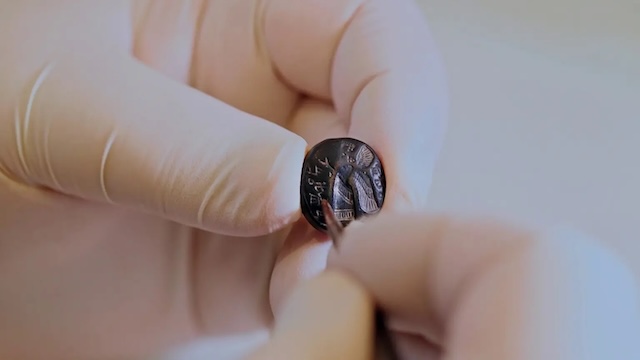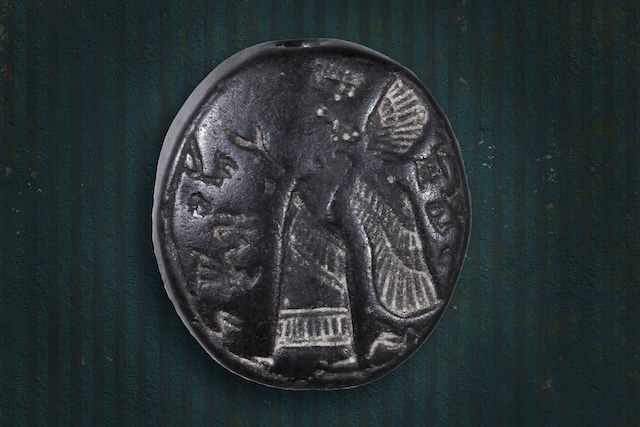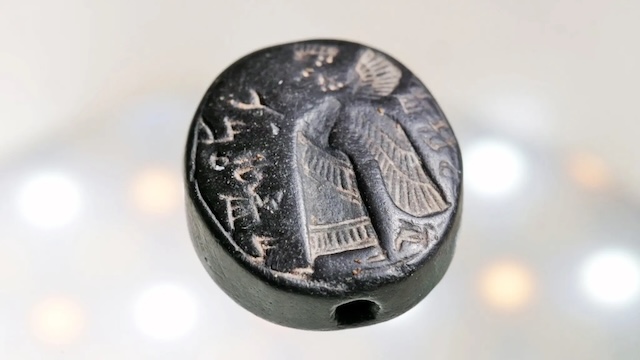Archaeologists have made a significant discovery in Jerusalem that could reshape our understanding of ancient literacy and cultural exchange. A 2,700-year-old black stone amulet, featuring a unique combination of ancient script and a winged figure, was unearthed during a joint excavation by the Israel Antiquities Authority (IAA) and the City of David Foundation. This discovery provides new insights into reading, writing, and symbolic art in the Kingdom of Judah during the late First Temple period.
An Ancient Seal with a Personal Inscription
The artifact, found in the Davidson Archaeological Garden, was identified as an ancient seal bearing the paleo-Hebrew inscription “Le Yehoʼezer ben Hosh’ayahu,” which translates to “For Yeho’ezer son of Hosh’ayahu.” This inscription is thought to be connected to two high-ranking men, likely officials in the Kingdom of Judah’s administration, who may have lived between the 10th and 6th centuries BCE. The inscription is particularly significant because it was written in mirror writing, allowing the seal to imprint its message onto wax.
Interestingly, the presence of a small hole in the stone suggests that this seal was not just a functional object, but also a personal talisman. Archaeologists believe the seal could have been worn around the neck as a protective charm, symbolizing both authority and spiritual protection.

A Unique Winged Figure: Assyrian Influence?
The seal’s most remarkable feature, however, is the depiction of a winged figure, which experts believe is influenced by Assyrian art from the 9th-7th centuries BCE. The figure is thought to represent a “genie” or protective demon, a figure commonly found in Neo-Assyrian art but never before discovered in Israeli or regional archaeology. This fusion of cultural elements suggests a significant Assyrian influence on Judah during this period, when the Assyrians ruled over the region.
According to Dr. Filip Vukosavovic, an archaeologist and Assyriologist with the IAA, this is the first time such a figure has been found in Israel, making the seal a highly unusual and groundbreaking discovery.
The Seal’s Historical and Cultural Context
Archaeologists theorize that the seal was originally crafted for a man named Hosh’ayahu, an official in the Kingdom of Judah. After Hosh’ayahu’s death, his son Yeho’ezer inherited the seal and added his name to it, likely believing in the talisman’s magical qualities. This practice of passing down and modifying such artifacts reflects the deep cultural and spiritual significance of seals in ancient Judah.

In addition to its spiritual and personal value, the artifact raises questions about literacy in ancient Judah. While it was previously believed that literacy was restricted to the elite, the existence of such personal inscriptions suggests that reading and writing were more widespread. The seal’s inscription, though simple, demonstrates that knowledge of writing may have extended beyond the upper echelons of society, particularly for commercial or administrative purposes.
Changing Our Understanding of Ancient Literacy
The discovery of this 2,700-year-old artifact not only offers a glimpse into the personal and spiritual lives of ancient Judah’s officials but also challenges assumptions about literacy and education during this time. As Yuval Baruch of the IAA suggested, “It seems that literacy in this period was not the realm only of society’s elite.” This seal, with its combination of art, inscription, and functionality, reveals a complex society where knowledge of reading and writing played a key role in daily life, commerce, and governance.

Conclusion
The unearthing of this ancient seal in Jerusalem is an extraordinary find, offering new insights into the cultural, spiritual, and intellectual world of the Kingdom of Judah. The artifact’s combination of paleo-Hebrew inscription and Assyrian-inspired winged figure makes it a unique and rare piece in the region’s archaeological record. As researchers continue to analyze this seal, it promises to shed light on the intersection of art, literacy, and spiritual beliefs in ancient Judah, transforming our understanding of this ancient society.
